WATER CONSERVATION INSIDE THE DWELLING
Introduction
This chapter looks at whether and how Australian households conserve water inside their dwellings. It contains data on steps taken to save water in the laundry, kitchen, bathroom and toilet. It also looks at grey water collection and use and water conservation devices such as dual flush toilets.
The proportion of households in each state that reported conserving water in wet rooms (laundry, kitchen, bathroom and toilet) is shown in table 4.7. A large proportion of households saved water in their dwellings, the bathroom being the most common room where 66.5% of households reported water saving activities followed by the laundry (63.9%) and the kitchen (49.9%). Only 39.8% reported saving water in the toilet.
Victorian households led the way in reported water saving activities in the laundry (71.9%), the kitchen (58.0%) and the bathroom (75.6%). Queensland reported the greatest proportion of households that saved water in the toilet (44.0%). The Northern Territory, reported the least water saving activities in each of the rooms (graph 4.1). This may not be surprising given the Northern Territory has no water supply problems at present (NRETA 2007).
4.1 Households that took steps to save water(a), Inside the dwelling
: 2007
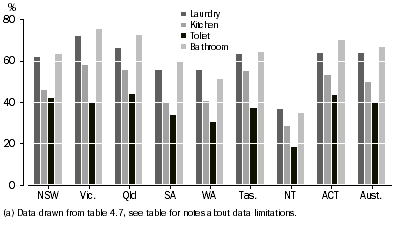
Common water saving activities of Australian households
Victoria, Queensland, the Australian Capital Territory and Tasmania all reported high proportions of households participating in water saving activities. All of these states have been subject to water restrictions imposed by water authorities or local councils (table 4.7 graph 4.1).
The most common ways in which Australian households reported saving water were through more efficient use of water. For example, in the laundry the greatest proportion, 27.9% of households (2,187,800), reported saving water by only using the washing machine when it was full (table 4.8). Other common ways in which households saved water, were by purchasing a more water efficient washing machine (10.9%) and by using grey water for the laundry (10.4%).
The most common water saving activities in the toilet were flushing less often or only when needed (17.0 %) and using the half flush of the dual flush toilet (16.9%) (table 4.9).
Showering less or taking shorter showers was the way in which the greatest proportion of households reported saving water in the bathroom (36.9%) (table 4.10). Turning off the tap while cleaning teeth or shaving was the second greatest proportion (23.9%).
In the kitchen, 15.6% of households reported saving water, by waiting until they had a full sink of dishes before doing the washing up (table 4.11), and 11.2% of households reported only using the dishwasher when it was full.
Interestingly Tasmania, where there were only limited water restrictions in place in March 2007, consistently had the highest proportion of households reporting certain water saving activities. For example, using the plug in the sink, tub or basin, Tasmania recorded the highest proportion in the laundry (13.6%), bathroom (17.1%) and the kitchen (23.2%, although this figure also includes respondents who didn't leave the tap running). Checking for leaking taps and pipes was also a water saving activity more common in Tasmania than the other states and territories. In the laundry, 16.5% of Tasmanian households checked for leaks, 8.2% in the toilet, 16.4% in the bathroom and 14.6% in the kitchen (tables 4.8, 4.9, 4.10 and 4.11).
Grey water use and collection
A substantial proportion of Australian households collected greywater for reuse inside and outside the dwelling, and in the garden. Almost one-quarter (24.4%) of Australian households reported collecting grey water in the laundry in the 12 months leading up to March 2007. In the bathroom, 18.9% of households reported collecting grey water, and 12.5% reported collecting grey water in the kitchen (tables 4.8, 4.10 and 4.11 respectively).
Victoria had the highest proportion of households who reported collecting grey water. In the laundry, 41.4% of Victorian households reported collecting grey water, 38.9% in the bathroom, and 25.8% in the kitchen (tables 4.8, 4.10 and 4.1 respectively and graph 4.2). The Australian Capital Territory consistently had the second greatest proportion of households reporting the collection of grey water in various rooms. One-third of households (33.3%) reported collecting grey water in their laundry, 29.4% in the bathroom and 18.6% in the kitchen. The Northern Territory's water resources are considered relatively plentiful therefore, Northern Territorian households had the lowest reported rates of grey water collection.
4.2 Households that collected greywater, Where collected
: 2007
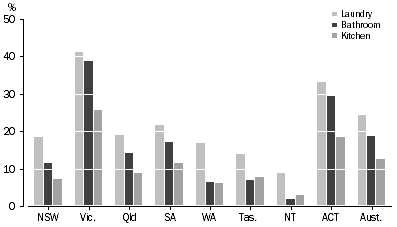
The use of grey water within the dwelling has only been considered in the laundry and toilet. In the laundry, 10.4% of Australian households used grey water (table 4.8 and graph 4.3). South Australian households had the greatest proportion (13.7%) that used grey water to wash clothes, followed closely by Victoria (13.3%) and the Australian Capital Territory (12.7%). Only 1.7% of Australian households used grey water to flush the toilet and the greatest proportion was in Victoria where 2.8% households reported doing so.
4.3 Households that used grey water, Inside the dwelling
: 2007
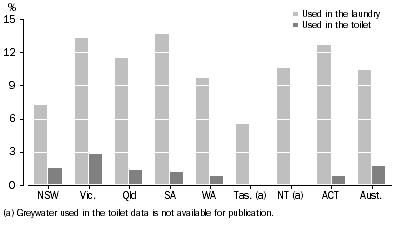
Householders who either owned or were paying off their homes had a higher proportion reporting the collection and use of greywater than households that rented (tables 4.12, 4.13, 4.14 and 4.15). For example, in the laundry, more than one-third (34.9%) of owners and 30.2% of purchasers collected or used greywater compared to 18.2% of renters. Households that were paying all the costs of their water had a higher proportion (31.9%) collecting and using grey water in the laundry than households where someone else paid the water bill (17.6%). Family households were more likely to report the collection of grey water than group households. For example in the bathroom, almost one-fifth (19.9%) of family households reported collecting grey water, whereas only 9.9% of group households did the same.
Water conservation devices
One of the easiest ways in which households can save water in the home is to install water-efficient or low flow shower heads and dual-flush toilets. In 2007 at least one water-efficient shower head was installed in the dwellings of more than half of Australian households (55.1%) (table 4.18 and graph 4.4), this was comprised of 47.1% of households with water-efficient shower heads only and 8.0% with both water-efficient and regular shower heads (table 4.16). The proportion was even higher for dual-flush toilets, with 80.9% of households reporting that they had at least one dual-flush toilet, comprised of 74.8% with dual-flush toilets only and 6.1% with both dual-flush and regular toilets (table 4.16 and graph 4.5).
4.4 Households with water-efficient shower head installed: 1994 to 2007
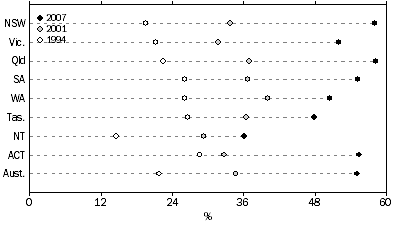
New South Wales had the greatest proportion of households which reported having water-efficient shower heads only in their dwelling 50.1% (table 4.16). Western Australia had the greatest proportion of households which reported having dual-flush toilets only in their dwelling (81.3%).
Victoria had the greatest proportion of households with at least one dual-flush toilet installed (85.1%), with 79.2% of households having dual-flush toilets only and a further 5.9% that had both dual-flush and regular toilets (tables 4.16 and 4.18 and graph 4.5).
The age of the dwelling appears to be an important factor when looking at the likelihood of dwellings having water-efficient devices installed. Almost three-quarters (74.4%) of dwellings which were less than one year old had only water-efficient shower heads installed. This figure fell to less than a half (45.8%) of dwellings more than 30 years old (table 4.17 and graph 4.6).
4.5 Households with dual-flush toilet installed: 1994 to 2007
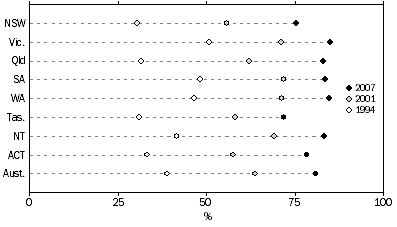
The likelihood of dual-flush toilets in dwellings also appears to be related to the age of the dwelling. Where the dwellings were less than one year old 96.0% of households reported having dual-flush toilets only. This figure fell to 64.0% of households where the dwelling was more than 30 years old. The dual-flush toilet was developed in 1981 (State Library of South Australia, 2007) so dwellings more than 26 years old must have had the dual-flush toilet retro-fitted.
Table 4.18 shows the uptake of both water-efficient shower heads and dual-flush toilets since 1994. In June 1994, only 21.8% of Australian households had a water-efficient shower head and 39.0% had a dual-flush toilet. These figures have risen steadily over the last 13 years to 55.1% for water-efficient shower heads and 80.9% for dual-flush toilets (graphs 4.4 and 4.5).
By 2007, more that 17 million water conservation devices were installed in the dwellings of Australian households, 6.4 million water-efficient shower heads and 10.8 million dual-flush toilets (table 4.19).
4.6 Age of dwelling, Water saving devices installed
: 2007
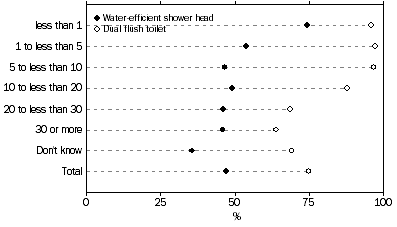
 Print Page
Print Page
 Print All
Print All